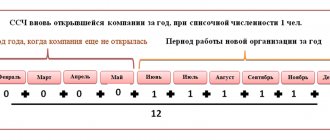Separate reporting forms for LLCs and individual entrepreneurs, mandatory for submission to the tax office, extra-budgetary funds or statistical service, contain an indicator of the average headcount. For different purposes, different types of determining the number of personnel of an organization are used:
Friends, joy! We have made a calculator to calculate the average number of employees. Use it!
- actual number;
- turnout numbers;
- staffing levels;
- planned number;
- standard number;
- average number.
Various algorithms are used to determine each value; both employees on the company’s payroll and all employees, regardless of employment status (internal and external part-time workers, temporary and seasonal workers, “contractual workers”) can be counted.
Question: What are the features of calculating the average number of employees for newly created organizations? View answer
How to calculate the required number of employees
Methods for calculating the number of personnel
To make the calculations, you don’t have to contact an accountant or HR officer; you can do everything yourself. For this purpose, there are methods for calculating the number of personnel.
- Regulatory
- calculated according to the standards from the Labor Code of the Russian Federation. Calculation of the staffing norm shows how many employees there should be ideally, when no one goes on vacation, gets sick or goes on a business trip. Does not take into account business specifics and force majeure.
Suitable if you are just planning to open a business and roughly estimate how many people will work, how much to pay them and how best to draw up a budget. You won’t get exact results, but you will be able to get your bearings at the start, when you have a minimum of specific numbers on hand.
- Planned
- also calculated according to the standards of the Labor Code of the Russian Federation, but already takes into account the specifics of the company: what it produces or sells, how many hours each employee works per week, etc. The results are more accurate than when calculating according to dry standards.
Suitable if you have a revenue goal for the year or season. You need to calculate how many employees will be needed to make this plan a reality.
- List (actual)
- shows how many total employees work at the enterprise under an employment contract.
It will be needed when you need to evaluate the performance of employees, determine the average salary, or calculate the staff turnover rate - how often people quit. You can request this information from your accountant or human resources department.
- Average
- shows how many employees worked in the company per month or year.
The business has already started. It's time to fill out tax reports. To do this, you need to calculate the average number of personnel for a specific period of time. It does not take into account those who are on maternity leave, working remotely or under a contract.
- Attendance
- takes into account only those employees who are at the workplace.
Gives an understanding of how many people should go to work every day so that the work process is not interrupted and the service does not sag
- Regular
- takes into account the specifics of the business: revenue, number of working hours, volume of work per employee. The calculation includes all employees plus people who are needed to replace those who go on sick leave or vacation. To do this, the absenteeism rate is added to the calculations.
You draw up a staffing schedule that will not change during a specific period. There must be enough people in it so that the work plan is fulfilled, no one is underworked or overloaded, and there is enough budget for salaries.
Each type of headcount calculation serves its own purposes. If you want to expand or reduce your staff, then you should calculate the staffing level. How to do it? We'll look at it in the next chapter.
Characteristics of this type of reporting
At any enterprise, workers can have a completely different status: some can be permanent employees, others can be temporary, and others can be seasonal and hired for short periods, that is, to perform one-time work.
The number of employees is constantly counted by the managers of an officially registered enterprise, as required by government agencies. By submitting voluminous reports on the number of their employees, enterprise managers have by law the full right to receive certain privileges from the tax services, which are expressed in some financial benefits and simplification of future reporting on the operation of the enterprise.
The main indicators in this case are the total and payroll number of working citizens. The difference between them is quite noticeable:
- The total number is the entire number of individuals included in the list of employees of the enterprise who have a direct labor relationship with the employer.
- The payroll number is a sum that shows the number of workers on the balance sheet of the enterprise. It is drawn up with direct accounting of the working time spent by them.
Determining the exact headcount is beneficial to entrepreneurs for other reasons. For example, this helps to conduct a kind of analysis of employee performance, find out about the enterprise’s need for new employees or to replace those employees who are absent for some significant reason. Based on this information, the employer can restructure the principles of the team’s work in order to reduce the loss of working hours.
In some cases, the payroll itself includes such a concept as turnout. This number takes into account the number of workers themselves and takes into account primarily jobs and the amount of time employees spend at work.
Summarizing everything written above, we can say that the payroll number of employees is understood as special reporting submitted by the heads of the enterprise to government bodies, which contains information that determines the number of all working individuals in the organization. The information informs about the personnel composition of the structure and the recording of working hours. The employer who provides this information receives relief from the tax authorities.
Calculation of staffing levels
Staffing is the number of people needed to complete the work plan for a specific period. It takes into account the average number of sales per employee. For example, 10 trips to Sochi per week, 5 apartment transactions per month.
Additionally, the error, or the coefficient of fulfillment of the norm, is calculated. It shows how much work in the plan differs from what happened in practice last year or month.
Calculation formula:
- V is the planned amount of work that needs to be completed over a specific period of time: month, year, quarter, shift. For example, earn 1 million rubles by sewing 20 wedding dresses.
- FW - how much time it takes to complete the plan. For example, 10 hours or 1 year to earn 500 thousand rubles.
- IDP - how much each employee must sell or produce during the FW. Here we take only the sales department and those who produce the product or service, we do not take into account the cleaning lady, office manager, etc.
- KVN - coefficient of fulfillment of the norm. It shows the error between how much was actually earned in the past period and how much is planned now. For example, in March we made 10 cakes, in April we are planning 15.
Calculation of the number of personnel using an example.
The store employs 10 people. The owner decided to cut costs and reduce the number of staff. Before doing this, he calculated using a formula how many people should be on staff for optimal work. The data is as follows: V - 1,180,000 rubles in revenue for 12 months; Federal Reserve Bank - 1,980 hours per year with a 9-hour working day, taking into account holidays and force majeure; IDPs - 118,000 rubles in revenue per person per year and 60 rubles/hour (118,000/1,980); KVN - 1.18, it was obtained as a result of the calculation: 1.18 million rubles divided by 1 million rubles of revenue for the previous year. We count: 1,180,000/(1980 x 60 x 1.18) = 8 people. This means that the staff is slightly overstaffed: 10 people are working, and two employees can be made redundant.
Calculation using this method gives an approximate result: it does not take into account that sometimes employees go on vacation or maternity leave, get sick or quit. To make the results more realistic, you need to calculate the absenteeism rate and include it in the general formula. It will show how many people are needed so that the process does not stop if someone is not at work.
Stage 1. Calculation of work time per unit of work volume.
At the first stage of calculating the number of workers, it is necessary to determine how many man-hours are required to process one unit of work (in our case, to accept and store one pallet). To do this, it is necessary to take a photograph of working time and determine its structure. An example of the structure of a receptionist's working hours:
To calculate the work time per unit of production, we will need the share of time for unavoidable breaks (in the example - 13%) and the share of time for rest and personal needs (in the example - 20%). You will also need timing data for operational work, which will help establish the average time for performing operations with one unit of volume. In our example, this time for scanning and moving one pallet is 0.007 hours (42 seconds). The work time per unit volume is equal to the time of operational work (0.007 hours), taking into account the time for rest (+20%) and for fatal breaks (+13%).
The time standard should not include time for unproductive work and time for avoidable breaks (highlighted in orange in the diagram). However, this decision must be supported by organizational measures - to establish a supply of pallets for receiving workers, to improve labor discipline. In consulting projects, we draw up a separate action plan to increase labor productivity.
How to calculate the number of employees taking into account the human factor
Formula for calculating the absenteeism rate:
- KN—absenteeism rate. Characterizes the number of people who cannot go to work due to illness, take leave or go on maternity leave.
- DN - the share of non-working time in the total amount of time. This is the FRB figure from the previous formula (1,980 hours).
Example of calculating absenteeism rate
After the store owner considered that he could reduce the sales staff by two people, he decided to clarify the result to make sure that in case of dismissal the quality of service would not decrease. To do this, he calculated the employee absenteeism rate over a 12-month period. It turns out that each employee goes on vacation for 28 days, or 252 hours, per year. DN = 252 hours/1,980 hours (FRV indicator) = 0.13. 1 + 0.13 = 1.13 is the absenteeism rate.
Now we will calculate the number of personnel of the enterprise along with the absenteeism rate.
Formula for staffing (SH) taking into account the absenteeism rate (AB):
Let's add an example
In the calculation, it turned out that the staff of 10 people can be reduced to 8. Now let’s calculate the number along with the absenteeism rate (1.13).
8 x 1.13 = 9
This means that the store must have at least 9 employees. Therefore, you can only fire one person
Stage 3. Calculation of the target number of workers.
The target number is equal to the volume of work per shift (in pieces) divided by the production rate per shift.
The resulting estimated number of workers is rounded according to the following rule: the number is rounded up if, after rounding, the load on each staff unit does not exceed 115%. That is, a target number of less than 1.15 staff units is rounded to 1, and more than 1.15 is rounded to 2. A target number of less than 2.3 staff units is rounded to 2, and more than 2.3 – to 3. And so on. Based on this principle, any target number above seven staff positions is rounded down.
What to do if you don't like the results
Calculation results may differ from reality. For example, you are expanding your business, and, according to the figures, you need to hire 4 more people, but there is no budget for their salaries. Or vice versa: you need to optimize the salary fund, and the numbers say that you can fire 2 people, but in reality there are not enough people, everyone is being sewn up anyway. What to do in such cases?
For example, consider two situations.
Situation 1: Need to hire more people, but no money
In this case, you can optimize your workflows:
- Improve staff qualifications
by sending them to courses or training in a related profession. Before doing this, you need to figure out what will be cheaper: hiring a new employee or paying for training for the old one. Sometimes both options are not suitable at once. - Outsourcing some of the tasks
is suitable if the outsourcing contractor will cost less than a full-time employee with a white salary. - Automate work using a CRM system
- it will remove some of the routine tasks from employees. As a result, staff productivity will increase, and you won’t have to hire more people. - Motivate
- measure productivity and reward achievements. For example, give bonuses, make unusual gifts, offer training courses. All this increases productivity, people will do more than before and may not have to hire anyone.
Try these methods to increase staff productivity and see what happens. If none of these methods help, then you are left with few options: hire a person at least part-time or consult a business analyst so that he can analyze your processes and, possibly, identify the cause of the problem.
Situation 2: you need to cut costs and fire someone, but there are already few staff
A crisis occurred and demand for products fell sharply. The easiest way to straighten out the situation and reduce costs as quickly as possible is to fire an employee. We calculate the number of personnel in the organization and it turns out that there is no one to fire. On the contrary, it is advisable to hire at least one more person to the team.
What can be done:
- Compile a time sheet - study the productivity of employees
during the day or week. How efficiently they work, what they are distracted by, perhaps someone is lazy or very late. It happens that the problem is precisely the staff, and not the heavy workload. Dismiss the lazy people, distribute their tasks evenly among those who are not busy all day. - Conduct recertification
- find out whether everyone knows their responsibilities well or whether someone has lost their skills. This way you will separate irreplaceable employees from those who cannot cope: they can be sent to advanced training courses or fired. - Introduce a system of fines and warnings
, set stricter deadlines. These measures will bring staff into good shape and improve performance indicators. Those who fail will deservedly receive a lower salary. - Optimize processes using a CRM system
- it will take over part of the operations. As a result, the volume of work will be reduced, and you will need fewer people to do it than before, which means you can fire someone without sacrificing quality of service.
If it is necessary to fire someone no matter what measures are taken, there is always the opportunity to get by with a little bloodshed. For example, if you have vacancies in other departments, you can try to retrain the employees you are planning to fire and transfer them to another position.
Keep in mind that when optimizing staff, it is easy to lose valuable personnel: fire someone who does their job really well and leave an incompetent employee. To prevent this from happening, re-certification and timing are required.
Stage 4. Personnel analysis and planning.
The resulting calculation of the number of workers demonstrates that the product receivers in our warehouse are overloaded (the actual load is more than 115%). As a result, products are received with delays and overall warehouse efficiency decreases. At the same time, the remaining employees are underutilized. Storekeepers are idle for more than half of their working time. Calculating the target number of workers helps to level out the workload of personnel (and therefore increase productivity) and at the same time reduce personnel costs, according to the example, by almost 30%.
Be sure to submit information about the number of employees to the tax office
Employers are no longer required to submit average headcount information as a self-report. This is stated in the amendments to the Tax Code of the Russian Federation. That is, it is no longer possible to report on the number of employees in any form.
The changes came into force on January 1, 2022. And if previously every employer was required to submit such a report annually, now data on the number of employees in the organization must be included in the calculation of insurance premiums (DAM).
It is necessary for all organizations with hired employees to submit information on the average number of employees (ASN). An exception is individual entrepreneurs without employees.
to fill out the RSV on the Consultant’s website.
filling out the RSV.
How to calculate the average number of employees
The annual MSS is the sum of the monthly one. To calculate the monthly average, you need to add up the number of employees for each day and divide by the number of days in the month.
The calculation takes into account:
- employees on vacation;
- employees on sick leave.
The calculation does not take into account:
- women on maternity leave;
- employees under GPC agreements;
- employees on unpaid study leave;
- employees on parental leave.
For example, as of 02/01/2021, the company employs 50 people. One employee goes on maternity leave on February 16, and another employee goes on maternity leave on the same day. This means that from the 16th they will not be taken into account in the calculation. From February 1 to February 15 (15 days) - 50 people. From February 16 to February 28 (13 days) - 48 people. We count: (50 x 15) + (48 x 13) = 1374 Then we divide this amount by the number of days in February: 1374:28 = 49
To calculate the annual NHI, such a calculation must be made for each month. Then add up the resulting numbers for each month and divide by 12 - the number of months in a year.
Definition
The headcount is the number of all workers of any particular organization. This includes everyone, including those who work in different departments, other structural units, do their work at home, are hired only for a certain time (season), and so on. Absolutely everything is specified as integers. For example, even a person who works only for one season, and not for the whole year, will be counted as a unit on the payroll of the enterprise, and not as 0.25. The exception is those categories of employees who combine work, do not have an employment contract, or groups of people working on the basis of a civil contract.
Cheat sheet for calculating headcount
In order not to get lost among formulas and numbers, let’s put everything into a checklist:
1. If you need to balance the work of the company’s personnel, consider the number of employees.
2. To calculate, use the formula H = V / (FRV x VPL x KVN).
3. To calculate the number taking into account those who may get sick or go on vacation, calculate the absenteeism rate using the formula KN = 1 + DN.
4. Supplement the formula for calculating staffing levels with the absenteeism rate. The formula looks like: ШЧ = H x KN.
5. When you need to submit information to the tax office, consider the average number of employees.
6. If the numbers are not clear and you still need to fire someone, or there is no money to hire new employees, optimize work processes, identify lazy people, tighten deadlines, motivate, connect CRM.
Author: Anna Naumkina, Daria Milakova
Basic provisions
Absolutely any enterprise that has its own balance sheet must compile a payroll number of workers. It must also clearly refer to legal entities. All information about various divisions, teams, laboratories and similar structures that are part of the company is also provided according to the same principles. It must be remembered that even if the department is not actually part of the company, but formally belongs to it, it must appear in the general report. The exception is those divisions that have their own balance sheet. Here, at the request of the main structure, they can either provide the necessary information to the central office or transfer it independently to the territorial statistical bodies.
The report preparation process is broken down by time frame. There are monthly, quarterly and annual varieties. In each of them, you should strictly adhere to the rule that the time period begins from the very first day of the period (even if it is a weekend, holiday, and so on) and also ends with the last date. For example, in terms of the year it will be from January 1 to December 31 without any exceptions. It is necessary to strictly adhere to the deadlines for submitting documents, as otherwise an error may appear and a fine will be imposed.
Headcount
This category includes absolutely all employees, regardless of how long they were hired, even if this period of time is only one day. A correctly compiled payroll number is the key to successful reporting without problems or errors. It is also necessary to take into account those workers who, for some reason, are not present at the enterprise for a certain period of time.
Considering the number of people who are required to be included in the report, and those who are not indicated in it, it is easier to list the latter. Thus, everyone who is not on the staff, works part-time or in accordance with a certain agreement that this individual has concluded with one or another government organization should not appear in the document. Employees who actually belong to this company, but currently work for another company, provided that they do not receive a salary at their main place, are also not taken into account.
Special mention should be made about the students. The payroll is a document about those who are currently working, but not about those who are undergoing training. That is, all potential employees who, at the time of drawing up the report, are studying, interning or otherwise gaining the necessary experience are not included in the report. As soon as they are fully and officially hired, only then will a mark about them appear in the appropriate document. And the last group of people who do not need to be reflected in the report are those who quit. Regardless of how this happened, the former employee is automatically removed from the list from the date of termination of employment.
What are the differences from the average
As we previously found out, the number of employees on the payroll is the number of people who have entered into an employment relationship with the organization in the form of an employment contract. This value is calculated for each day in whole units and corresponds to the number of people declared on the working time sheet. The resulting indicator is taken as the basis for calculating the average headcount, a significant value for statistics and taxation. Its calculation for a month is carried out as a calculation of the average value: the average value for each calendar day is summed up, the resulting amount is divided by the number of calendar days. The quarterly coefficient is calculated in a similar way. However, in order to obtain correct data when calculating both quantities, it is necessary to take into account a number of nuances.







